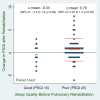Impact of pulmonary rehabilitation in sleep in COPD patients measured by actigraphy
- PMID: 33724995
- PMCID: PMC7963048
- DOI: 10.1371/journal.pone.0248466
Impact of pulmonary rehabilitation in sleep in COPD patients measured by actigraphy
Abstract
Introduction: Chronic obstructive pulmonary disease (COPD) patients have poor sleep quality, longer time to sleep onset and frequent nocturnal awakenings. Poor sleep quality in COPD is associated with poor quality of life (QoL), increased exacerbations and increased mortality. Pulmonary rehabilitation (PR) improves functional status and QoL in COPD but effects on sleep are unclear. PR improves subjective sleep quality but there is paucity of objective actigraphy data. We hypothesized that actigraphy would demonstrate subjective and objective improvement in sleep following PR. Paired comparisons (t-test or Wilcoxon-signed-rank test) were performed before and after PR data on all variables.
Methods: This retrospective study of COPD patients undergoing PR utilized actigraphy watch recordings before and after 8-weeks of PR to assess changes in sleep variables including total time in bed (TBT), total sleep time (TST), sleep onset latency (SOL), sleep efficiency (SE), wakefulness after sleep onset (WASO) and total nocturnal awakenings. A change in Pittsburg Sleep Quality Index (PSQI) was a secondary outcome. PSQI was performed before and after PR.
Results: Sixty-nine patients were included in the final analysis. Most participants were male (97%), non-obese (median BMI 27.5, IQR 24.3 to 32.4 kg/m2) with an average age of 69 ± 8 years and 71% had severe COPD (GOLD stage 3 or 4). Prevalence of poor sleep quality (PSQI ≥5) was 86%. Paired comparisons did not show improvement in actigraphic sleep parameters following 8-weeks PR despite improvements in 6-min-walk distance (6MWD, mean improvement 54 m, 95% CI 34 m to 74 m, p<0.0001) and St. George's Respiratory Questionnaire scores (SGRQ, mean improvement 7.7 points, 95% CI 5.2 to 10.2, p<0.0001). Stratified analysis of all sleep variables by severity of COPD, BMI, mood, mental status, 6-MWD and SGRQ did not show significant improvement after PR. In Veterans with poor sleep quality (PSQI ≥ 5), PR improved subjective sleep quality (PSQI, mean difference 0.79, 95% CI 0.07 to 1.40, p = 0.03).
Conclusions: Pulmonary rehabilitation improved subjective sleep quality in Veterans who had poor sleep quality at the beginning of the PR but did not improve objective sleep parameters by actigraphy. Our findings highlight the complex interactions among COPD, sleep and exercise.
Conflict of interest statement
The authors have declared that no competing interests exist.
Figures


Similar articles
-
Pulmonary rehabilitation improves sleep efficiency measured by actigraphy in poorly sleeping COPD patients.Sci Rep. 2023 Jul 13;13(1):11333. doi: 10.1038/s41598-023-38546-3. Sci Rep. 2023. PMID: 37443292 Free PMC article.
-
Pulmonary rehabilitation improves subjective sleep quality in COPD.Respir Care. 2014 Oct;59(10):1569-76. doi: 10.4187/respcare.02912. Epub 2014 Jun 10. Respir Care. 2014. PMID: 24917453
-
Effectiveness of pulmonary rehabilitation in exercise capacity and quality of life in chronic obstructive pulmonary disease patients with and without global fat-free mass depletion.Arch Phys Med Rehabil. 2013 Aug;94(8):1607-14. doi: 10.1016/j.apmr.2013.02.005. Epub 2013 Feb 14. Arch Phys Med Rehabil. 2013. PMID: 23416765
-
Efficacy of pulmonary rehabilitation in improving the quality of life for patients with chronic obstructive pulmonary disease: Evidence based on nineteen randomized controlled trials.Int J Surg. 2020 Jan;73:78-86. doi: 10.1016/j.ijsu.2019.11.033. Epub 2019 Dec 13. Int J Surg. 2020. PMID: 31843677
-
Significance of Pulmonary Rehabilitation in Improving Quality of Life for Subjects With COPD.Respir Care. 2019 Jan;64(1):99-107. doi: 10.4187/respcare.06353. Respir Care. 2019. PMID: 30578361
Cited by
-
Pulmonary rehabilitation improves sleep efficiency measured by actigraphy in poorly sleeping COPD patients.Sci Rep. 2023 Jul 13;13(1):11333. doi: 10.1038/s41598-023-38546-3. Sci Rep. 2023. PMID: 37443292 Free PMC article.
-
The Effect of Sleep Impairment, as Assessed by the CASIS Questionnaire, in Patients with Chronic Obstructive Pulmonary Disease on Disease Severity and Physical and Mental Health: A Cross-Sectional Study in Primary Care.Biomedicines. 2024 Jul 24;12(8):1644. doi: 10.3390/biomedicines12081644. Biomedicines. 2024. PMID: 39200109 Free PMC article.
-
The impact of pulmonary rehabilitation on sleep quality in patients with chronic obstructive pulmonary disease: A systematic review and meta-analysis.PLoS One. 2025 Jun 4;20(6):e0318424. doi: 10.1371/journal.pone.0318424. eCollection 2025. PLoS One. 2025. PMID: 40465766 Free PMC article.
-
Sleep Quality and Self-Reported Symptoms of Anxiety and Depression Are Associated with Physical Activity in Patients with Severe COPD.Int J Environ Res Public Health. 2022 Dec 14;19(24):16804. doi: 10.3390/ijerph192416804. Int J Environ Res Public Health. 2022. PMID: 36554684 Free PMC article.
-
Comparison of the Effects of Diaphragmatic Breathing and Pursed-lip Breathing Exercises on the Sleep Quality of Elderly Patients with Chronic Obstructive Pulmonary Disease (COPD): A Clinical Trial Study.Ther Adv Pulm Crit Care Med. 2024 Dec 5;19:29768675241302901. doi: 10.1177/29768675241302901. eCollection 2024 Jan-Dec. Ther Adv Pulm Crit Care Med. 2024. PMID: 39640085 Free PMC article.
References
-
- Klink M. and Quan S.F., Prevalence of reported sleep disturbances in a general adult population and their relationship to obstructive airways diseases. Chest, 1987. 91(4): p. 540–6. - PubMed
MeSH terms
LinkOut - more resources
Full Text Sources
Other Literature Sources
Medical
Research Materials

